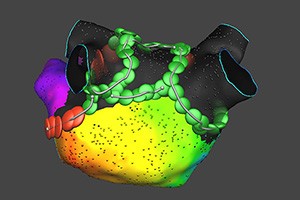One of the First in U.S.
By Marti Webb Slay
Patients with chronic pain now have a new treatment option with a spinal cord stimulator that is designed to offer long-term relief. The University of Alabama at Birmingham Pain Treatment Clinic at UAB Hospital-Highlands is one of the first clinics in the U.S. and the first in Alabama to offer the procedure.
The stimulator, which is implanted during outpatient surgery, sends electrical impulses into the spinal cord. The device responds to the spinal cord in real time and can adjust the electrical output 50 to 100 times per second based on what is happening in the spinal cord.
Christopher Paul, MD, a physician in the clinic and assistant professor in the UAB Department of Anesthesiology and Perioperative Medicine, explained what is involved. “The way most stimulators on the market work is that the device is programmed by a representative,” he said. “The patient can turn up the intensity, but it’s within a general program. As a patient’s situation changes over time, they could be underdosed or overdosed with electrical stimulation, leading to the patient’s spending more time outside of their therapeutic window. This device reads the action potentials at spinal cord level and reacts to that, so it is modulating the output of electricity in therapeutic ranges. It’s really kind of revolutionary.
“It is fascinating to look at what is going on at the spinal cord level in clinic and adjust therapy to what is happening physiologically in the patient’s body. We’ve never been able to do that before. It’s potentially like a cardiologist seeing an EKG for the first time. We are getting direct feedback from the spinal cord.”
Indications include patients with post-laminectomy syndrome, persistent spinal pain syndrome, or lumbar radiculopathy. Generally, the leads will be implanted in the mid-thoracic spine in the epidural space, which is where the fibers are passing through that are being stimulated.
To qualify for the procedure, patients must have had persistent pain for at least six months without relief from more conventional treatment such as injections and physical therapy. Most payers require a neuropsychological evaluation as well. “We make sure they have reasonable expectations and no untreated depression or anxiety,” Paul said. “They have to have a qualifying diagnosis. Stimulators are not all things to all people. We really try to have patients that are likely to succeed with this.
“Once the patient has qualified, they enter into a trial. We place the leads through needles and then remove the needles, leaving the leads in place. The patients have these leads for seven to 10 days. It’s like a test drive. They go home and work with us, the device, and the device representative. And at the end, we take off the bandages and remove the leads. There are no incisions. If they get at least a 50 percent reduction in pain, the vast majority of payors will let them go on and get the permanent implant. That usually occurs three to four weeks after the lead pulls.”
The implant requires outpatient surgery under general anesthesia. Two small skin incisions are required during the one-hour procedure. “Most patients recover quite well from it, and go home two to three hours after surgery,” Paul said.
He sees an expanding future for this new technology. “It’s starting to take off,” he said. “A lot of this technology is going to get rolled out to other devices long-term. This company happens to be the first to bring this to market. It may be a little while before others catch up, but I do see the long-term outcomes that have been published exceeding what is currently on the market. I feel like this is going to catch on pretty quickly.”
Paul has treated four patients with this procedure so far, but several more are in the process to receive the device, and he expects that he and his colleagues will be performing the procedure more, and sooner rather than later.
“We try to get the right device for the right patient with the right diagnosis,” Paul said. “There may be reasons why patients would get something besides this; maybe a different brand or a different technology. But largely this is going to make a big difference for a lot of patients.”













